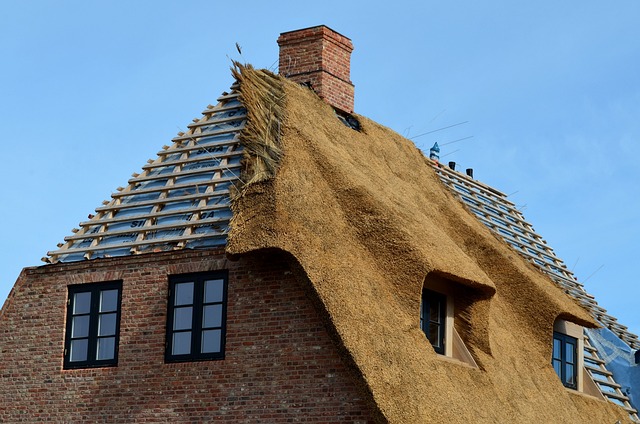Weather-resistant roofing materials are a smart investment for homeowners, offering protection against environmental damage and costly repairs. These materials, designed for durability, prevent leaks, mold growth, and structural weakening. By understanding regional climate needs and implementing proper maintenance, including regular inspections and gutter cleaning, homeowners can ensure their roofs' longevity and integrity, saving on long-term repairs. Incorporating waterproof membranes and strategic flashing is crucial for roof leak prevention systems in harsh climates.
In regions prone to extreme weather, safeguarding your home starts with a robust roof. This article delves into the world of weather-resistant materials, exploring their pivotal role in protecting against relentless elements. We guide you through identifying common roof leak sources and offer tailored solutions for various climates. From selecting the ideal waterproofing products to mastering proper installation and maintenance, discover the secrets to implementing effective roof leak prevention systems.
Understanding Weather-Resistant Materials: Their Role in Roof Protection
Weather-resistant materials play a crucial role in safeguarding your home’s most vulnerable point—the roof—from the elements, thus preventing costly roof leak prevention systems from becoming necessary. These materials are designed to endure extreme temperatures, high winds, heavy rainfall, and other harsh climate conditions, ensuring your roof remains intact and secure for years to come. From durable shingles and tiles to robust underlayments, each component contributes to a comprehensive defense against the outdoors.
By investing in weather-resistant solutions, homeowners can significantly reduce the risk of damage caused by water intrusion, mold growth, and structural weakening. Modern innovations in roofing technology have resulted in advanced materials that not only withstand harsh climates but also offer improved insulation, energy efficiency, and aesthetic appeal. These characteristics make weather-resistant materials a smart choice for any property owner looking to protect their investment and ensure the long-term integrity of their roof.
Identifying Common Roof Leak Sources and Their Prevention
Roof leaks are a common issue, especially in regions with harsh climates and frequent storms. Identifying and preventing these leaks is crucial to maintaining a weather-resistant roof. Common sources include damaged or missing shingles, deteriorated flashing around chimneys and vents, and weak spots from tree branches or falling debris. Regular inspections can help detect these issues early.
Implementing effective roof leak prevention systems involves using high-quality materials resistant to extreme conditions. This includes installing waterproof membranes under shingles and ensuring proper sealing around critical areas like valleys and ridges. Additionally, maintaining gutters clear of debris prevents water overflow, which can lead to leaks. Regular maintenance and timely repairs are key to safeguarding against costly damage caused by roof leaks.
Choosing the Right Weatherproofing Products for Your Climate
When it comes to selecting weather-resistant materials, understanding your specific climate is key. Different regions present unique challenges that require tailored solutions. For instance, areas prone to heavy rainfall need products that excel at roof leak prevention systems, such as high-quality flashings and waterproof membranes. In contrast, colder climates demand materials that can withstand snow and ice build-up, emphasizing the importance of robust sealing and insulation.
Choosing the right weatherproofing products ensures your structure’s longevity. Local weather patterns will guide you in selecting materials designed to resist specific elements, be it strong winds, intense sunlight, or extreme temperatures. This proactive approach not only prevents damage but also saves on long-term repairs, making it an essential step for any property owner facing harsh climates.
Installing Waterproof Membranes and Flashing Properly
When it comes to installing weather-resistant materials, a crucial step is incorporating waterproof membranes and flashing. These are essential components in any roof system designed to withstand harsh climates and prevent costly roof leak prevention systems from becoming necessary. Waterproof membranes provide an extra layer of protection against moisture intrusion, ensuring that even the most intense storms cannot penetrate your roof’s surface.
Proper installation of these membranes and flashing is paramount. Professionals should ensure seamless integration between the membrane and the existing roofing material, sealing any gaps or overlaps to prevent water from seeping in. Flashing, which are thin sheets of waterproof material installed around various roof penetrations like chimneys and vents, further reinforces these vulnerable areas. By addressing these critical points, homeowners can rest assured that their roofs are better equipped to handle extreme weather conditions, reducing the likelihood of costly repairs due to water damage.
Regular Maintenance Tips to Ensure Longevity of Weather-Resistant Systems
Regular maintenance is key to ensuring that weather-resistant materials and roof leak prevention systems remain effective over time. It’s important to schedule routine inspections, especially in regions prone to extreme weather conditions. During these checks, look for signs of damage, such as broken or missing shingles, loose fixtures, or any evidence of water intrusion. Promptly addressing these issues can prevent minor problems from escalating into costly repairs.
Additionally, keeping the drainage system clear and functional is crucial. Clogged gutters and downspouts can lead to roof overflow, compromising the integrity of weather-resistant barriers. Regular cleaning and maintenance will ensure proper water flow, reducing the risk of roof leaks and extending the life of your weather-resistant systems.
Implementing weather-resistant materials and proper installation techniques is a proactive approach to protect your roof from harsh climates and prevent costly roof leak prevention systems. By understanding common leak sources, selecting climate-appropriate products, and maintaining your roofing system, you can significantly extend its lifespan. These measures ensure your home remains safe and secure, even in the face of extreme weather conditions, ultimately saving you time and money in the long run.
